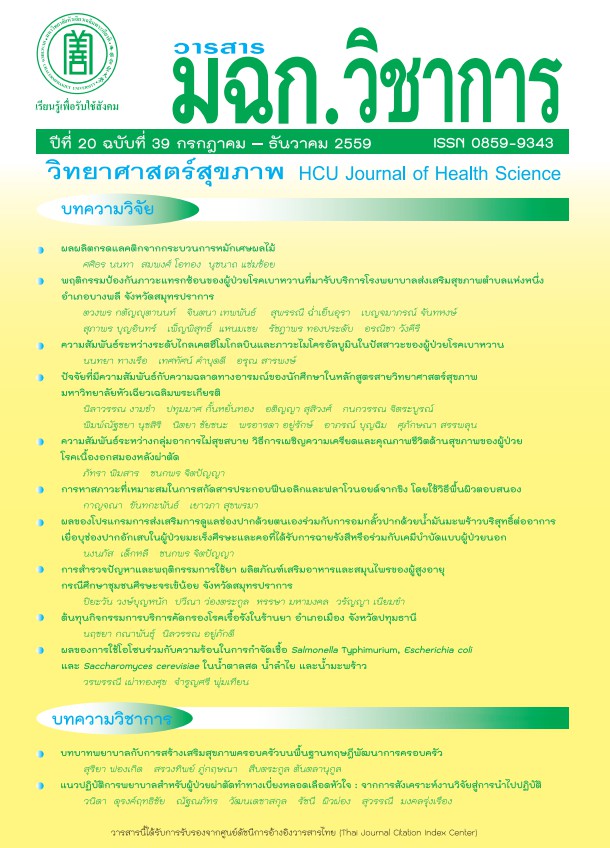Combination Effect of Ozone and Heat Treatments for the Inactivation of Salmonella Typhimurium, Escherichia coli and Saccharomyces cerevisiae in Coconut Syrup, Dried Longan Drink and Coconut Juice
Keywords:
Ozone, foodborne pathogens, fruit drink, coconut syrup, dried longan drink, coconut juiceAbstract
The purpose of this study involved the use of ozone in combination with temperature for the treatment of bacteria (Salmonella Typhimurium and Escherichia coli) and yeast (Saccharomyces cerevisiae) in coconut syrup, dried longan drink and coconut juice at the initial density of 107 CFU/mL. After inoculation with bacteria or yeast, fruit drinks were ozonated with 300 mg-O3/h into 1 L of juice at 2.5 L/min flow rate. The experiments were operated in combination with low (4oC), high (50oC) and room (30oC) temperatures. Sterile air bubbling was used as a control. It was found that bacteria and yeast in juice could be inactivated by 1.2 - 6.5 log CFU/mL after ozone treatment. Altering in temperature by either low or high temperature significantly enhanced the efficiencies of ozone. Ozone could inactivate Salmonella Typhimurium and Escherichia coli at comparable efficiency but Saccharomyces cerevisiae had higher ozone tolerance. The optimal condition for both bacterial and yeast treatment obtained from this study was the combination of ozone at high temperature (50oC) which could inactivate the microorganisms at more than 7 log CFU/mL.
Downloads
References
จังหวัดมหาสารคาม” วารสารวิจัยสาธารณสุขศาสตร์ มหาวิทยาลัยขอนแก่น. 5 (3) หน้า 87-96.
Abid, M. et al. (November 2014) “Synergistic impact of sonication and high hydrostatic pressure on microbial and enzymatic inactivation of apple juice” LWT - Food
Science and Technology. 59 page 70-76.
Broadwater, W. T., Hoehn, R. C. and King, P. H. (September 1973) “Sensitivity of three selected bacterial species to ozone” Journal of Applied Microbiology. 26 page
391-393.
Buchanan, R. L. et al. (November 1998) “Inactivation of Escherichia coli O157:H7 in apple juice by irradiation” Apply and Environmental Microbiology. 64 page 4533-
4535.
Chavasit, V., Kunhawattana, S. and Jirarattanarangsri, W. (August 2006) “Production and contamination of pasteurized beverages packed in sealed plastic containers in
Thailand and potential preventive measures” Food Control. 17 page 622-630.
Choi, M. R. et al. (October 2012) “Inactivation of Escherichia coli O157:H7, Salmonella Typhimurium and Listeria monocyotgenes in apple juice with gaseous ozone”
Food Microbiology. 32 page 191-195.
Guzel-Seydim, Z. B., Greene, A. K. and Seydim, A. C. (June 2004) “Use of ozone in the food industry” Lebensm.-wiss. u.-Technol. 37 page 453-460.
Kim, J., Yousef, A. E., and Khadre, M. A. (September 2003) “Ozone and its current and future application in the fooindustry” Advances in Food and Nutrition
Research. 45 page 167-218.
Moore, G., Griffith, C. and Peters, A. (August 2000) “Bactericidal properties of ozone and its potential application as a terminal disinfectant” Journal of Food Protection.
63 (8) page 100-1106.
Patil, S. et al. (September 2010) “Inactivation of Escherichia coli by ozone treatment of apple juice at different pH levels” Food Microbiology. 27 page 835-840.
Restaino, L. et al. (September 1995) “Efficacy of ozonated water against various foodrelated microorganisms” Applied and Environmental Microbiology. 61 (9) page
3471-3475.
Sung, H. J. et al. (February 2014) “Combination effect of ozone and heat treatments for the inactivation of Escherichia coli O157:H7, Salmonella Typhimurium, and Listeria
monocytogenes in apple juice” International Journal of Food Mirobiology. 171 page 147-153.
Tiwari, B. K. et al. (April 2009) “Effect of ozone processing on anthocyanins and ascorbic acid degradation of strawberry juice” Food chemistry. 113 page 1119-1126.
Torlak, E. (February 2014) “Efficacy of ozone against Alicyclobacillus acidoterrestris spores in apple juice” International Journal of Food Microbiology. 172 page 1-4.
Ukuku, D. O. and Geveke, D. J. (March 2010) “A combined treatment of UV-light and radio frequency electric field for the inactivation of Escherichia coli K-12 in apple
juice” International Journal of Food Microbiology. 138 page 50–55.
U.S. Food and Drug Administration. (January 2001) “Hazard analysis and critical point (HACCP); procedures for the safe and sanitary processing and importing of juice;
final rule” Federal Register. 66 page 6138.
U.S. Food and Drug Administration. (2000) Bacteriological Analytical Manual (BAM) (8th ed.). [Online] Available : http://www.fda.gov/BAM (25 July 2009)
Williams, R. C., Summer, S. S. and Golden, D. A. (November 2004) “Survival of Escherichia coli O157:H7 and Salmonella in apple cider and orange juice as a affected
by ozone and treatment temperature” Journal of Food Protection. 67 page 2381-2386.
Downloads
Published
How to Cite
Issue
Section
License
บทความที่ได้รับการตีพิมพ์เป็นลิขสิทธิ์ของวารสารวิทยาศาสตร์สุขภาพและสุขภาวะ
ข้อความที่ปรากฏในบทความแต่ละเรื่องในวารสารวิชาการเล่มนี้เป็นความคิดเห็นส่วนตัวของผู้เขียนแต่ละท่านไม่เกี่ยวข้องกับมหาวิทยาลัยหัวเฉียวเฉลิมพระเกียรติ และคณาจารย์ท่านอื่นๆในมหาวิทยาลัยฯ แต่อย่างใด ความรับผิดชอบองค์ประกอบทั้งหมดของบทความแต่ละเรื่องเป็นของผู้เขียนแต่ละท่าน หากมีความผิดพลาดใดๆ ผู้เขียนแต่ละท่านจะรับผิดชอบบทความของตนเองแต่ผู้เดียว




